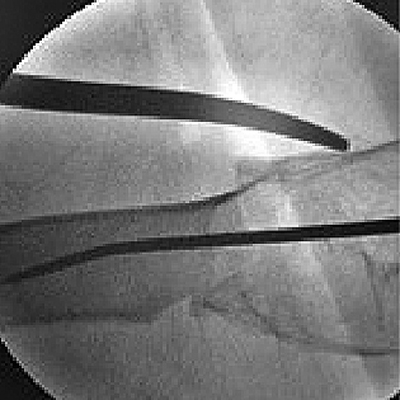Actualización del tratamiento de las fracturas intertrocantéricas
Contenido principal del artículo
Resumen
Descargas
Métricas
Detalles del artículo
La aceptación del manuscrito por parte de la revista implica la no presentación simultánea a otras revistas u órganos editoriales. La RAAOT se encuentra bajo la licencia Creative Commons 4.0. Atribución-NoComercial-CompartirIgual (http://creativecommons.org/licenses/by-nc-sa/4.0/deed.es). Se puede compartir, copiar, distribuir, alterar, transformar, generar una obra derivada, ejecutar y comunicar públicamente la obra, siempre que: a) se cite la autoría y la fuente original de su publicación (revista, editorial y URL de la obra); b) no se usen para fines comerciales; c) se mantengan los mismos términos de la licencia.
En caso de que el manuscrito sea aprobado para su próxima publicación, los autores conservan los derechos de autor y cederán a la revista los derechos de la publicación, edición, reproducción, distribución, exhibición y comunicación a nivel nacional e internacional en las diferentes bases de datos, repositorios y portales.
Se deja constancia que el referido artículo es inédito y que no está en espera de impresión en alguna otra publicación nacional o extranjera.
Por la presente, acepta/n las modificaciones que sean necesarias, sugeridas en la revisión por los pares (referato), para adaptar el trabajo al estilo y modalidad de publicación de la Revista.
Citas
osteosynthesis in the treatment of unstable pertrochanteric fractures. J Clin Med 2018;7(4):78.
https://doi.org/10.3390/jcm7040078
2. Hardy DC, Descamps PY, Krallis P, Fabeck L, Smets P, Bertens CL, et al. Use of an intramedullary hip-screw
compared with a compression hip-screw with a plate for intertrochanteric femoral fractures: a prospective,
randomized study of one hundred patients. J Bone Joint Surg Am 1998;80(5):618-30.
https://doi.org/10.2106/00004623-199805000-00002
3. Baumgaertner MR, Curtin SL, Lindskog DM, Keggi JM. The value of the tip-apex distance in predicting failure
of fixation of peritrochanteric fractures of the hip. J Bone Joint Surg Am 1995;77(7):1058-64.
https://doi.org/10.2106/00004623-199507000-00012
4. Bidolegui F, Vindver G, Di Stefano C. Manejo de las fracturas inestables del fémur proximal con el clavo PFN de la AO/ASIF. Evaluación de una serie prospectiva de 100 casos. Rev Asoc Argent Ortop Traumatol 2008;73(1):55-62.
Disponible en: http://www.aaot.org.ar/revista/2008/n1_vol73/art09.pdf
5. Koval KJ, Oh CK, Egol KA. Does a traction-internal rotation radiograph help to better evaluate fractures of the
proximal femur? Bull NYU Hosp Jt Dis 2008;66(2):102-6. PMID: 18537778
6. Lyon T, Koval KJ, Kummer F, Zuckerman JD. Pudendal nerve palsy induced by fracture table. Orthop Rev 1993;
22(5):521-5. PMID: 8316416
7. Rikli D, Goldhahn S, Blauth M, Mehta S, Cunningham M, Joeris A, PIP Study group. Optimizing intraoperative
imaging during proximal femoral fracture fixation – a performance improvement program for surgeons. Injury
2018;49(2):339-44. https://doi.org/10.1016/j.injury.2017.11.024
8. Yong-Cheol Yoon, Chang-Wug Oh, Jae-Ang Sim, Jong-Keon Oh. Intraoperative assessment of reduction quality
during nail fixation of intertrochanteric fractures. Injury 2020;51(2):400-6. https://doi.org/10.1016/j.injury.2019.10.087
9. Ottolenghi CE, Japas LM. Lateral fractures of the femur neck: the extradigital type. Rev Chir Orthop Reparatrice
Appar Mot 1964;50:389-98. PMID: 14186381
10. Young Soo Chun, Hyunsup Oh, Yoon Je Cho, Kee Hyung Rhyu. Technique and early results of percutaneous
reduction of sagittally unstable intertrochateric fractures. Clin Orthop Surg 2011;3(3):217-24. https://doi.
org/10.4055/cios.2011.3.3.217
11. Yong-Cheol Yoon, Ashutosh Jha, Chang-Wug Oh, Senthil Kumar Durai, Young-Woo Kim, Jong-Hoon Kim,
et al. The pointed clamp reduction technique for spiral subtrochanteric fractures: A technical note. Injury
2014;45(6):1000-5. https://doi.org/10.1016/j.injury.2014.01.007
12. Carr JB. The anterior and medial reduction of intertrochanteric fractures: A simple method to obtain a stable
reduction. J Orthop Trauma 2007;21:485-9. https://doi.org/10.1097/BOT.0b013e31804797cf
13. Ostrum RF, Marcantonio A, Marburger R. A critical analysis of the eccentric starting point for trochanteric
intramedullary femoral nailing. J Orthop Trauma 2005;19:681-6. https://doi/org/10.1097/01.bot.0000184145.75201.1b
14. O’Malley MJ, Kang KK, Azer E, Siska PA, Farrell DJ, Tarkin IS. Wedge effect following intramedullary hip screw
fixation of intertrochanteric proximal femur fracture. Arch Orthop Trauma Surg 2015;135(10):1343-7.
https://doi.org/10.1007/s00402-015-2280-0
15. Hak DJ, Bilat C. Avoiding varus malreduction during cephalomedullary nailing of intertrochanteric hip fractures. Arch Orthop Trauma Surg 2011;131:709-10. https://doi.org/10.1007/s00402-010-1182-4
16. Yu Zhang, Jun Hu, Xiang Li, Xiaodong Qin. Reverse wedge effect following intramedullary nailing of a
basicervical trochanteric fracture variant combined with a mechanically compromised greater trochanter. BMC
Musculoskelet Disord 2020;21(1):195. https://doi.org/10.1186/s12891-020-03212-6
17. Kuzyk PR, Zdero R, Shah S, Olsen M, Waddell JP, Schemitsch EH. Femoral head lag screw position for
cephalomedullary nails: a biomechanical analysis. J Orthop Trauma 2012;26:414-21. https://doi.org/10.1097/BOT.0b013e318229acca
18. Curtis R, Goldhahn J, Schwyn R, Regazzoni P, Suhm N. Fixation principles in metaphyseal bone—a patent based review. Osteoporos Int 2005;16(Suppl 2):S54-S64. https://doi.org/10.1007/ s00198-004-1763-6
19. Pernille Bovbjerg, Lonnie Froberg, Hagen Schmal. Short versus long intramedullary nails for treatment of
intertrochanteric femur fractures (AO 31‐A1 and AO 31‐A2): a systematic review. Eur J Orthop Surg Traumatol
2019;29(8):1823-31. https://doi.org/10.1007/s00590-019-02495-3
20. Nobuaki Chinzei, Takafumi Hiranaka, Takahiro Niikura, Mitsuo Tsuji, Ryosuke Kuroda, Minoru Doita, et al.
Comparison of the sliding and femoral head rotation among three different femoral head fixation devices for
trochanteric fractures. Clin Orthop Surg 2015;7(3):291-7. https://doi.org/10.4055/cios.2015.7.3.291
21. Sommers MB, Roth C, Hall H, Kam BCC, Ehmke LW, Krieg JC, et al. A laboratory model to evaluate cutout
resistance of implants for pertrochanteric fracture fixation. J Orthop Trauma 2004;18:361-8.
https.//doi.org/10.1097/00005131-200407000-00006
22. Shuang Li, Shi‐Min Chang, Wen‐Xin Niu, Hui Ma. Comparison of tip apex distance and cut‐out complications
between helical blades and lag screws in intertrochanteric fractures among the elderly: a meta‐analysis. J Orthop Sci 2015;20:1062-9. https://doi.org/10.1007/s00776-015-0770-0
23. Ibrahim I, Appleton PT, Wixted JJ, DeAngelis JP, Rodriguez EK. Implant cut-out following cephalomedullary
nailing of intertrochanteric femur fractures: Are helical blades to blame? Injury 2019;50(4):926-30.
https://doi.org/10.1016/j.injury.2019.02.015
24. Caiaffa V, Vicenti G, Mori C, Panella A, Conserva V, Conserva V, et al. Is distal locking with short intramedullary
nails necessary in stable pertrochanteric fractures? A prospective, multicentre, randomised study. Injury
2016;47(Supp4):S98-S106. https//doi.org/10.1016/j.injury.2016.07.038
25. Wen-Shan Yan, Wei-Li Cao, Ming Sun, Deng-Yue Ma, Peng Zhang. Distal locked or unlocked nailing for stable
intertrochanteric fractures? A meta-analysis. ANZ J Surg 2020;90(1-2):27-33. https://doi.org/10.1111/ans.15232

